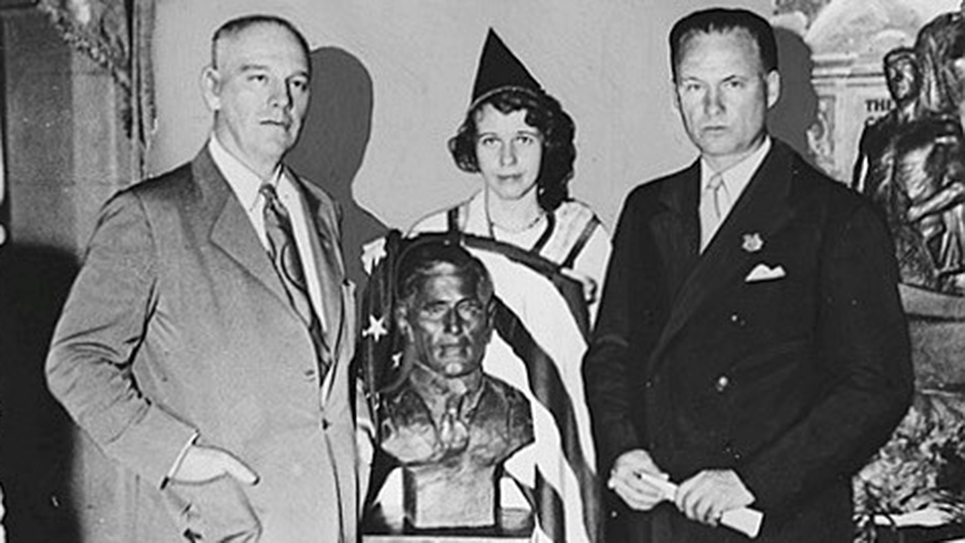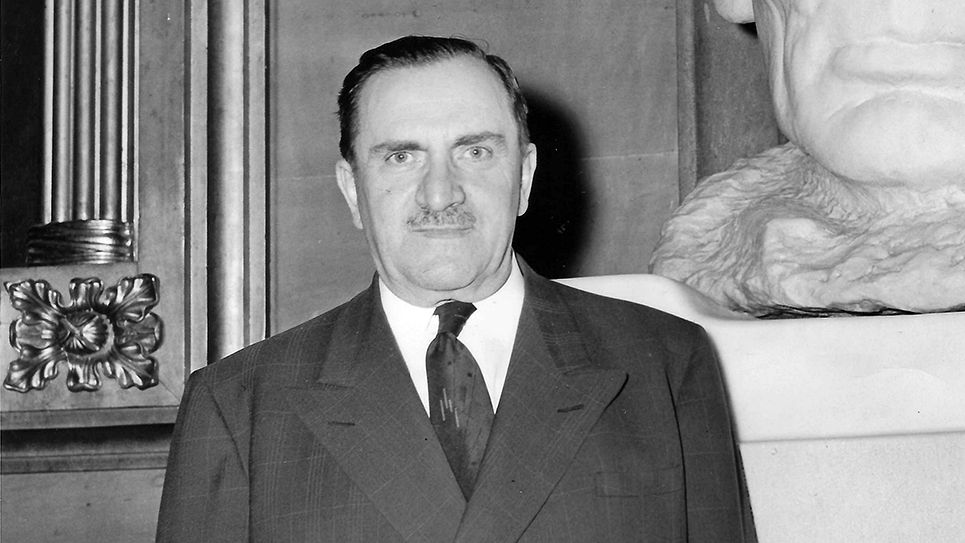There are those who remember Paul Wellstone, the United States senator from Minnesota, who died, along with his wife and daughter, while campaigning for reelection in 2002 when his chartered airplane crashed. Wellstone, however, was not the first United States senator from Minnesota to die in an airplane crash. That unfortunate distinction belongs to Ernest Lundeen who died in what was the worst commercial air disaster in American history to that point. Lundeen was headed home to Minnesota on August 31, 1940, when he and the twenty-three others in the plane were killed when the Pennsylvania Commercial airliner crashed in Lovettsville, Virginia, near the Blue Ridge Mountains. Ironically, Senator Lundeen had been the sponsor of the legislation which created the Civil Aeronautics Board following the death of Bronson Cutting, the U. S. senator from New Mexico who had been killed in an airplane crash in 1935.
Lundeen was a fiery speaker, capable of moving audiences with his words. Indeed, Ernest Lundeen had been a Minnesota state champion orator. Lundeen became a successful attorney practicing in Minneapolis. Ernest Lundeen’s life was comprised of practicing law and running for office every two years or more. Following two unsuccessful races for a seat in the Minnesota House of Representatives, Lundeen finally managed to get himself twice elected to the state house.
In 1914, Lundeen opted to attempt to move up the political ladder, choosing to run against incumbent Congressman George Ross Smith, who was seeking his second term inside the Republican primary. Ernest Lundeen was not successful, but he won an impressive 45% of the vote. Lundeen tried again two years later, and a third candidate pulled enough votes inside the GOP primary that the challenger upset Congressman Smith by 474 votes.
Almost immediately Congressman Ernest Lundeen was confronted by the prospect of declaring war against the German Empire in 1917. A great many of the people living in Minnesota were of German and Scandinavian descent and there was little internationalist sentiment in the North Star State. Lundeen was against the military draft and voted against the declaration of war against Germany. Lundeen was not the only congressman or freshman legislator to have opposed sending American boys to fight in Europe. Congressman Harold Knutson, who represented a rural district in Minnesota, who had also been first elected in 1916, voted against the declaration of war. Lundeen, however, represented perhaps the most metropolitan area of the state and it was likely the one spot inside Minnesota where there was more internationalist sentiment. Alderman John T. Kean and Judge Giddings said Congressman Lundeen was a disgrace to Minnesota. “Minnesota is entitled to loyal men in Congress – – – not to men of the caliber of Ernest Lundeen,” Judge Giddings cried. It would not be the last time Lundeen would be accused of disloyalty to his country.
Lundeen, far from being apologetic or attempting to placate the internationalists inside his congressional district, doubled down and introduced a bill to repeal the draft. Many Americans and some Minnesotans felt Lundeen’s actions were unpatriotic. One newspaper editorial declared, “Lundeen’s course gives aid and comfort to the enemy.” The same editorial wryly surmised that the congressman might well not be “concerned about these evidences of popular displeasure” on the part of the public.
A resolution was drafted by the Lake Harriet Commercial Club to expel the congressman from its membership. After club members had requested Lundeen resign his membership “by reason of his disloyal and unpatriotic attitude,” the congressman refused. The resolution cited Congressman Lundeen’s “public utterances” to have been “disloyal and seditious” and charged Lundeen had “endeavored to obstruct the government in its prosecution of the war. . .” Former President Theodore Roosevelt was enraged by Lundeen’s vote against entering the First World War and sneered the congressman was a “shadow Hun” as well as a “lesser microbe.”
Whatever else might be said about Ernest Lundeen, he did not lack for the courage of his convictions. Lundeen was opposed to United States entry into the First World War and budged neither a jot nor a tiddle in his position. Congressman Ernest Lundeen was utterly unapologetic about his stand and was certain he had been right in having opposed American participation in the war.
It could have surprised exactly no one when a host of prospective congressmen entered the Republican primary to replace Ernest Lundeen in 1918. Four men challenged Congressman Lundeen for the GOP nomination for Congress from Minnesota’s Fifth District. The eventual winner was Walter Hughes Newton, although Congressman Lundeen ran second. Newton went on to be elected five times before resigning to become secretary (chief of staff) to President Herbert Hoover in the summer of 1929.
Lundeen tried to win back his seat in Congress two years later when he once again ran inside the Republican primary. That time Lundeen faced Walter Newton in a three-man contest, but the incumbent won decisively.
In between practicing law to pay his bills, Ernest Lundeen never stopped trying to get back into Congress. Lundeen became a candidate for the Republican nomination for the U. S. Senate against Senator Frank B. Kellogg but lost with just over a third of the votes cast. Lundeen ran dead last in the GOP primary in a 1923 special election for the U. S. Senate. In 1924, Lundeen lost a primary election in his bid to become Chief Justice of the Minnesota State Supreme Court.
It was after that failed race Lundeen dropped his affiliation with the Republican Party and became a member of the Minnesota Farmer-Labor Party. At the time, the Farmer-Labor Party had elected Henrik Shipstead to the United States Senate and would dominate the governor’s office within a few years. Ernest Lundeen became the Farmer-Labor Party candidate for Minnesota’s Tenth Congressional District against incumbent Congressman Godfrey B. Goodwin. Lundeen did little better than he had as a Republican, winning just over a third of the ballots cast. In 1928, Ernest Lundeen carried the banner of his new party as the Farmer-Labor candidate for governor against incumbent Theodore Christianson. Lundeen ran ahead of the Democratic candidate and earned second place, but the former congressman polled only 22% of the vote.
When his successor in Minnesota’s Fifth Congressional District resigned to become President Hoover’s secretary, a special election was called and naturally, Ernest Lundeen became a candidate. Lundeen ran third, behind the winning Republican and a losing Democrat. Lundeen was the nominee of the Farmer-Labor Party for the United States Senate in 1930. Lundeen’s constant campaigning for office paid off when he defeated Congressman Knud Wefald for the Farmer-Labor nomination. Lundeen had overturned the results of the Farmer-Labor state convention where Congressman Wefald had been endorsed at the insistence of gubernatorial candidate Floyd Olson. Lundeen carried the fight to the primary election where he beat Wefald, much to the annoyance of Floyd Olson.
Ernest Lundeen ran third, behind incumbent Senator Thomas Schall and Democratic candidate Einar Hoidale, yet he polled an impressive 178,671 votes statewide.
Much ridiculed for his constant “public office hunting,” especially in the newspapers of the day, Ernest Lundeen’s persistence finally paid off in 1932. That year the failure of the state legislature to redistrict caused every congressional candidate in Minnesota to run statewide, rather than by district. Nine seats in Congress were at stake in the 1932 general election and several incumbents lost that year. Ernest Lundeen ran fourth in the at-large races for Congress. Magnus Johnson, a native of Sweden with a thick accent, led the ticket in the races for Congress. Only one GOP incumbent congressman survived the 1932 election, Harold Knutson of the Fourth Congressional District.
By 1934 the congressmen were back to running in districts as the legislature had drawn proper congressional districts. Congressman Ernest Lundeen was reelected handsomely against three opponents in the general election.
1936 was an odd year in Minnesota politics. Political partisans were expecting an epic contest between Republican Senator Thomas Schall and Farmer-Labor Governor Floyd Olson for the Senate. Schall was legally blind and was mortally injured while crossing a street in Maryland by a hit-and-run driver in December of 1935. Schall died in a Washington, D.C., hospital days later. That same month Governor Floyd Olson went to the Mayo Clinic as he had long been plagued by severe stomach ulcers. The governor was actually suffering from stomach cancer. At the time, patients were frequently not made aware of their precise condition and Floyd Olson had no idea his cancer had been diagnosed as fatal. In fact, Olson may well not have even been told he had cancer. As Olson kicked off his campaign for the Senate, his cancer became worse. After making a speech on June 19, 1936, Governor Floyd Olson returned to the Mayo Clinic and died there on August 22. Olson was only forty-four years old.
Congressman Ernest Lundeen quickly moved to enter the race for the United States Senate and became the nominee of the Farmer-Labor Party. Republicans nominated Congressman Theodore Christianson as their own candidate. Christianson was thought to be a strong candidate, having been elected governor statewide previously. Lundeen, the perennial candidate, had the greatest victory of his career, winning better than 62% of the vote.
Once inside the United States Senate, Ernest Lundeen, along with his senior colleague, Henrik Shipstead, favored all neutrality legislation and remained a firm opponent of foreign entanglements. Lundeen remained very much an isolationist in his outlook on American foreign policy. Certainly, far from being pro-British, Senator Lundeen advocated the United States seizing Bermuda and other possessions of the British Empire to settle its debt from the First World War. Still, Senator Lundeen was a strong proponent of defending America. Lundeen was a big supporter of the notion championed by General Billy Mitchell, who contended the best defense of America was through building a strong air force. Lundeen was in favor of separating the air force from the Army and the Navy in its own command.
Lundeen was associated with George Sylvester Viereck, who was at the very least a German sympathizer, if not an actual German propagandist. That caused Lundeen to become suspect in the eyes of the FBI according to some sources.
It was estimated Senator Ernest Lundeen had made more than 100 flights on Pennsylvania Central Airlines. Lundeen boarded a Pennsylvania Central Airlines flight bound for Pittsburgh and on to Minnesota.
A terrific storm was underway when Lundeen’s flight crashed in Lovettsville. Lester Mason was a farmer who lived very near where the plane plowed into the knoll of a hill at 300 miles per hour. Because of the torrential downpour of rain, there was no eyewitness to the actual crash but several people, Lester Mason included, hurried out of their homes after hearing what they thought was an explosion. Mason noted the lack of fire, speculating if the plane had burst into flames the rain had put it out by the time he and his neighbors reached the scene of the carnage.
According to the story in the Zanesville, Ohio Signal, Lester Mason grimly recalled the grisly details. “The plane was broken to bits and so were the bodies of the people in it,” Mason said softly.
“We stumbled on toward it. The pieces of wreckage were strewn all over a two-acre stretch of ground. So were the bodies.” Lester Mason recounted. “Those which were still whole were so badly mangled I don’t see how they could ever be recognized.”
Some residents claimed to have heard the plane circling above as if the pilot had been searching for a field in which to land.
TIME magazine reported, “The force of the crash was so great that, strapped in their seats, many of them were literally cut in two by their safety belts.”
Two of the people killed in the crash were FBI agents. The best information available is the FBI still hasn’t closed the books on the crash of Ernest Lundeen’s last flight.







